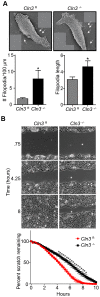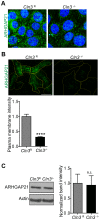CLN3 deficient cells display defects in the ARF1-Cdc42 pathway and actin-dependent events
- PMID: 24792215
- PMCID: PMC4008583
- DOI: 10.1371/journal.pone.0096647
CLN3 deficient cells display defects in the ARF1-Cdc42 pathway and actin-dependent events
Abstract
Juvenile Batten disease (juvenile neuronal ceroid lipofuscinosis, JNCL) is a devastating neurodegenerative disease caused by mutations in CLN3, a protein of undefined function. Cell lines derived from patients or mice with CLN3 deficiency have impairments in actin-regulated processes such as endocytosis, autophagy, vesicular trafficking, and cell migration. Here we demonstrate the small GTPase Cdc42 is misregulated in the absence of CLN3, and thus may be a common link to multiple cellular defects. We discover that active Cdc42 (Cdc42-GTP) is elevated in endothelial cells from CLN3 deficient mouse brain, and correlates with enhanced PAK-1 phosphorylation, LIMK membrane recruitment, and altered actin-driven events. We also demonstrate dramatically reduced plasma membrane recruitment of the Cdc42 GTPase activating protein, ARHGAP21. In line with this, GTP-loaded ARF1, an effector of ARHGAP21 recruitment, is depressed. Together these data implicate misregulated ARF1-Cdc42 signaling as a central defect in JNCL cells, which in-turn impairs various cell functions. Furthermore our findings support concerted action of ARF1, ARHGAP21, and Cdc42 to regulate fluid phase endocytosis in mammalian cells. The ARF1-Cdc42 pathway presents a promising new avenue for JNCL therapeutic development.
Conflict of interest statement
Figures








Similar articles
-
Unbiased Cell-based Screening in a Neuronal Cell Model of Batten Disease Highlights an Interaction between Ca2+ Homeostasis, Autophagy, and CLN3 Protein Function.J Biol Chem. 2015 Jun 5;290(23):14361-80. doi: 10.1074/jbc.M114.621706. Epub 2015 Apr 15. J Biol Chem. 2015. PMID: 25878248 Free PMC article.
-
Modulating membrane fluidity corrects Batten disease phenotypes in vitro and in vivo.Neurobiol Dis. 2018 Jul;115:182-193. doi: 10.1016/j.nbd.2018.04.010. Epub 2018 Apr 13. Neurobiol Dis. 2018. PMID: 29660499 Free PMC article.
-
Self-Complementary AAV9 Gene Delivery Partially Corrects Pathology Associated with Juvenile Neuronal Ceroid Lipofuscinosis (CLN3).J Neurosci. 2016 Sep 14;36(37):9669-82. doi: 10.1523/JNEUROSCI.1635-16.2016. J Neurosci. 2016. PMID: 27629717 Free PMC article.
-
The CLN3 gene and protein: What we know.Mol Genet Genomic Med. 2019 Dec;7(12):e859. doi: 10.1002/mgg3.859. Epub 2019 Sep 30. Mol Genet Genomic Med. 2019. PMID: 31568712 Free PMC article. Review.
-
Current Insights in Elucidation of Possible Molecular Mechanisms of the Juvenile Form of Batten Disease.Int J Mol Sci. 2020 Oct 29;21(21):8055. doi: 10.3390/ijms21218055. Int J Mol Sci. 2020. PMID: 33137890 Free PMC article. Review.
Cited by
-
Dysregulation of autophagy as a common mechanism in lysosomal storage diseases.Essays Biochem. 2017 Dec 12;61(6):733-749. doi: 10.1042/EBC20170055. Print 2017 Dec 12. Essays Biochem. 2017. PMID: 29233882 Free PMC article. Review.
-
Cellular models of Batten disease.Biochim Biophys Acta Mol Basis Dis. 2020 Sep 1;1866(9):165559. doi: 10.1016/j.bbadis.2019.165559. Epub 2019 Oct 23. Biochim Biophys Acta Mol Basis Dis. 2020. PMID: 31655107 Free PMC article. Review.
-
Antigen presenting cell abnormalities in the Cln3(-/-) mouse model of juvenile neuronal ceroid lipofuscinosis.Biochim Biophys Acta. 2016 Jul;1862(7):1324-36. doi: 10.1016/j.bbadis.2016.04.011. Epub 2016 Apr 19. Biochim Biophys Acta. 2016. PMID: 27101989 Free PMC article.
-
Lysosomal alterations and decreased electrophysiological activity in CLN3 disease patient-derived cortical neurons.Dis Model Mech. 2022 Dec 1;15(12):dmm049651. doi: 10.1242/dmm.049651. Epub 2022 Dec 13. Dis Model Mech. 2022. PMID: 36453132 Free PMC article.
-
Unbiased Cell-based Screening in a Neuronal Cell Model of Batten Disease Highlights an Interaction between Ca2+ Homeostasis, Autophagy, and CLN3 Protein Function.J Biol Chem. 2015 Jun 5;290(23):14361-80. doi: 10.1074/jbc.M114.621706. Epub 2015 Apr 15. J Biol Chem. 2015. PMID: 25878248 Free PMC article.
References
-
- Uvebrant P, Hagberg B (1997) Neuronal ceroid lipofuscinoses in Scandinavia. Epidemiology and clinical pictures. Neuropediatrics 28: 6–8. - PubMed
-
- Autti TH, Hamalainen J, Mannerkoski M, Van Leemput KV, Aberg LE (2008) JNCL patients show marked brain volume alterations on longitudinal MRI in adolescence. J Neurol 255: 1226–1230. - PubMed
-
- Autti T, Raininko R, Santavuori P, Vanhanen SL, Poutanen VP, et al. (1997) MRI of neuronal ceroid lipofuscinosis. II. Postmortem MRI and histopathological study of the brain in 16 cases of neuronal ceroid lipofuscinosis of juvenile or late infantile type. Neuroradiology 39: 371–377. - PubMed
Publication types
MeSH terms
Substances
Grants and funding
LinkOut - more resources
Full Text Sources
Other Literature Sources
Molecular Biology Databases
Research Materials
Miscellaneous

